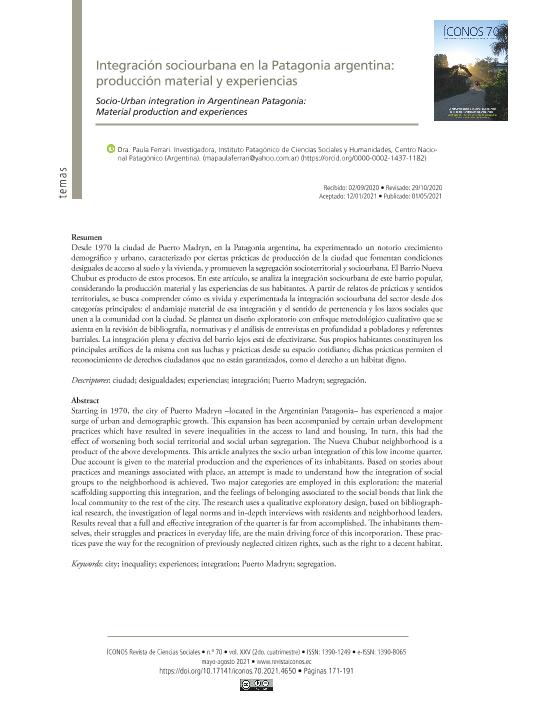Mostrar el registro sencillo del ítem
dc.contributor.author
Ferrari, María Paula

dc.date.available
2023-08-28T13:14:16Z
dc.date.issued
2021-05
dc.identifier.citation
Ferrari, María Paula; Integración sociourbana en la Patagonia Argentina: Producción material y experiencias; Facultad Latinoamericana de Ciencias Sociales Ecuador; Íconos; 70; 5-2021; 171-191
dc.identifier.issn
1390-1249
dc.identifier.uri
http://hdl.handle.net/11336/209488
dc.description.abstract
Desde 1970 la ciudad de Puerto Madryn, en la Patagonia argentina, ha experimentado un notorio crecimiento demográfico y urbano, caracterizado por ciertas prácticas de producción de la ciudad que fomentan condiciones desiguales de acceso al suelo y la vivienda, y promueven la segregación socioterritorial y sociourbana. El Barrio Nueva Chubut es producto de estos procesos. En este artículo, se analiza la integración sociourbana de este barrio popular, considerando la producción material y las experiencias de sus habitantes. A partir de relatos de prácticas y sentidos territoriales, se busca comprender cómo es vivida y experimentada la integración sociourbana del sector desde dos categorías principales: el andamiaje material de esa integración y el sentido de pertenencia y los lazos sociales que unen a la comunidad con la ciudad. Se plantea un diseño exploratorio con enfoque metodológico cualitativo que se asienta en la revisión de bibliografía, normativas y la concreción y análisis de entrevistas en profundidad a pobladores y referentes barriales. La integración plena y efectiva del barrio lejos está de efectivizarse. Sus propios habitantes constituyen los principales artífices de la misma con sus luchas y prácticas desde su espacio cotidiano; dichas prácticas permiten el reconocimiento de derechos ciudadanos que no están garantizados, como el derecho a un hábitat digno.
dc.description.abstract
Starting in 1970, the city of Puerto Madryn -located in the Argentinian Patagonia- has experienced a major surge of urban and demographic growth. This expansion has been accompanied by certain urban development practices which have resulted in severe inequalities in the access to land and housing. In turn, this had the effect of worsening both social territorial and social urban segregation. The Nueva Chubut neighborhood is a product of the above developments. This article analyzes the socio urban integration of this low income quarter. Due account is given to the material production and the experiences of its inhabitants. Based on stories about practices and meanings associated with place, an attempt is made to understand how the integration of social groups to the neighborhood is achieved. Two major categories are employed in this exploration: the material scaffolding supporting this integration, and the feelings of belonging associated to the social bonds that link the local community to the rest of the city. The research uses a qualitative exploratory design, based on bibliographical research, the investigation of legal norms and in-depth interviews with residents and neighborhood leaders. Results reveal that a full and effective integration of the quarter is far from accomplished. The inhabitants themselves, their struggles and practices in everyday life, are the main driving force of this incorporation. These practices pave the way for the recognition of previously neglected citizen rights, such as the right to a decent habitat.
dc.format
application/pdf
dc.language.iso
spa
dc.publisher
Facultad Latinoamericana de Ciencias Sociales Ecuador

dc.rights
info:eu-repo/semantics/openAccess
dc.rights.uri
https://creativecommons.org/licenses/by-nd/2.5/ar/
dc.subject
CIUDAD
dc.subject
DESIGUALDADES
dc.subject
EXPERIENCIAS
dc.subject
INTEGRACION
dc.subject.classification
Ciencias Sociales Interdisciplinarias

dc.subject.classification
Otras Ciencias Sociales

dc.subject.classification
CIENCIAS SOCIALES

dc.title
Integración sociourbana en la Patagonia Argentina: Producción material y experiencias
dc.title
Socio-Urban integration in Argentinean Patagonia: Material production and experiences
dc.type
info:eu-repo/semantics/article
dc.type
info:ar-repo/semantics/artículo
dc.type
info:eu-repo/semantics/publishedVersion
dc.date.updated
2023-07-07T21:30:59Z
dc.identifier.eissn
1390-8065
dc.journal.number
70
dc.journal.pagination
171-191
dc.journal.pais
Ecuador

dc.journal.ciudad
Quito
dc.description.fil
Fil: Ferrari, María Paula. Consejo Nacional de Investigaciones Científicas y Técnicas. Centro Científico Tecnológico Conicet - Centro Nacional Patagónico. Instituto Patagónico de Ciencias Sociales y Humanas; Argentina
dc.journal.title
Íconos
dc.relation.alternativeid
info:eu-repo/semantics/altIdentifier/doi/https://doi.org/10.17141/iconos.70.2021.4650
dc.relation.alternativeid
info:eu-repo/semantics/altIdentifier/url/https://iconos.flacsoandes.edu.ec/index.php/iconos/article/view/4650
Archivos asociados
